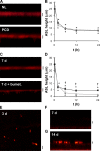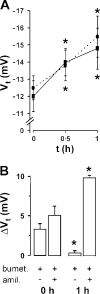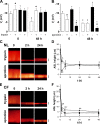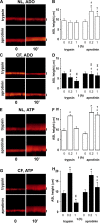Soluble mediators, not cilia, determine airway surface liquid volume in normal and cystic fibrosis superficial airway epithelia
- PMID: 16636206
- PMCID: PMC2151517
- DOI: 10.1085/jgp.200509468
Soluble mediators, not cilia, determine airway surface liquid volume in normal and cystic fibrosis superficial airway epithelia
Abstract
A key aspect of the lung's innate defense system is the ability of the superficial epithelium to regulate airway surface liquid (ASL) volume to maintain a 7-mum periciliary liquid layer (PCL), which is required for cilia to beat and produce mucus flow. The mechanisms whereby airway epithelia regulate ASL height to >or=7 microm are poorly understood. Using bumetanide as an inhibitor of Cl- secretion, and nystatin as an activator of Na+ absorption, we found that a coordinated "blending" of both Cl- secretion and Na+ absorption must occur to effect ASL volume homeostasis. We then investigated how ASL volume status is regulated by the underlying epithelia. Cilia were not critical to this process as (a) ASL volume was normal in cultures from patients with primary ciliary dyskinesia with immotile cilia, and (b) in normal cultures that had not yet undergone ciliogenesis. However, we found that maneuvers that mimic deposition of excess ASL onto the proximal airways, which occurs during mucociliary clearance and after glandular secretion, acutely stimulated Na+ absorption, suggesting that volume regulation was sensitive to changes in concentrations of soluble mediators in the ASL rather than alterations in ciliary beating. To investigate this hypothesis further, we added potential "soluble mediators" to the ASL. ASL volume regulation was sensitive to a channel-activating protein (CAP; trypsin) and a CAP inhibitor (aprotinin), which regulated Na+ absorption via changes in epithelial Na+ channel (ENaC) activity in both normal and cystic fibrosis cultures. ATP was also found to acutely regulate ASL volume by inducing secretion in normal and cystic fibrosis (CF) cultures, while its metabolite adenosine (ADO) evoked secretion in normal cultures but stimulated absorption in CF cultures. Interestingly, the amount of ASL/Cl- secretion elicited by ATP/ADO was influenced by the level of CAP-induced Na+ absorption, suggesting that there are important interactions between the soluble regulators which finely tune ASL volume.
Figures






Similar articles
-
Differential effects of cyclic and constant stress on ATP release and mucociliary transport by human airway epithelia.J Physiol. 2007 Apr 15;580(Pt. 2):577-92. doi: 10.1113/jphysiol.2006.126086. Epub 2007 Feb 22. J Physiol. 2007. PMID: 17317749 Free PMC article.
-
A2B adenosine receptors regulate the mucus clearance component of the lung's innate defense system.Am J Respir Cell Mol Biol. 2008 Aug;39(2):190-7. doi: 10.1165/rcmb.2007-0450OC. Epub 2008 Mar 26. Am J Respir Cell Mol Biol. 2008. PMID: 18367727 Free PMC article.
-
Inhibition of Protease-Epithelial Sodium Channel Signaling Improves Mucociliary Function in Cystic Fibrosis Airways.Am J Respir Crit Care Med. 2016 Sep 15;194(6):701-10. doi: 10.1164/rccm.201511-2216OC. Am J Respir Crit Care Med. 2016. PMID: 27014936
-
Regulation of normal and cystic fibrosis airway surface liquid volume by phasic shear stress.Annu Rev Physiol. 2006;68:543-61. doi: 10.1146/annurev.physiol.68.072304.112754. Annu Rev Physiol. 2006. PMID: 16460283 Review.
-
Regulation of airway surface liquid volume and mucus transport by active ion transport.Proc Am Thorac Soc. 2004;1(1):42-6. doi: 10.1513/pats.2306014. Proc Am Thorac Soc. 2004. PMID: 16113411 Review.
Cited by
-
Extracellular autocrine nucleotide signalling in a microenvironment: integrative physiology in a minute volume of airway surface liquid.J Physiol. 2007 Apr 15;580(Pt. 2):359-60. doi: 10.1113/jphysiol.2007.131805. Epub 2007 Mar 15. J Physiol. 2007. PMID: 17363380 Free PMC article. No abstract available.
-
SPLUNC1 regulates airway surface liquid volume by protecting ENaC from proteolytic cleavage.Proc Natl Acad Sci U S A. 2009 Jul 7;106(27):11412-7. doi: 10.1073/pnas.0903609106. Epub 2009 Jun 18. Proc Natl Acad Sci U S A. 2009. PMID: 19541605 Free PMC article.
-
ENaC proteolytic regulation by channel-activating protease 2.J Gen Physiol. 2008 Nov;132(5):521-35. doi: 10.1085/jgp.200810030. Epub 2008 Oct 13. J Gen Physiol. 2008. PMID: 18852303 Free PMC article.
-
Tight junctions in pulmonary epithelia during lung inflammation.Pflugers Arch. 2017 Jan;469(1):135-147. doi: 10.1007/s00424-016-1917-3. Epub 2016 Dec 5. Pflugers Arch. 2017. PMID: 27921210 Free PMC article. Review.
-
Inhibitors of pendrin anion exchange identified in a small molecule screen increase airway surface liquid volume in cystic fibrosis.FASEB J. 2016 Jun;30(6):2187-97. doi: 10.1096/fj.201600223R. Epub 2016 Mar 1. FASEB J. 2016. PMID: 26932931 Free PMC article.
References
-
- Alton, E.W., A. Khagani, M.H. Yacoub, and D.M. Geddes. 1989. Lack of effect of lung denervation on the measurement of potential difference after single-lung transplantation. N. Engl. J. Med. 320:1755 (letter). - PubMed
-
- Boucher, R.C. 1994. Human airway ion transport (Part 1). Am. J. Respir. Crit. Care Med. 150:271–281. - PubMed
-
- Bridges, R.J., B.B. Newton, J.M. Pilewski, D.C. Devor, C.T. Poll, and R.L. Hall. 2001. Na+ transport in normal and CF human bronchial epithelial cells is inhibited by BAY 39-9437. Am. J. Physiol. 281:L16–L23. - PubMed
Publication types
MeSH terms
Substances
Grants and funding
LinkOut - more resources
Full Text Sources
Other Literature Sources
Medical
Miscellaneous

